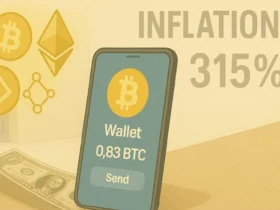As with any investment, cryptocurrencies have their own strategies to acquire and invest assets. Transaction costs, particularly while withdrawing funds, can be a nightmare.
Almost every crypto exchange, be it CEX or DEX, has some withdrawal fees. While bridging is often touted as a cheaper and faster alternative
Crypto users need to be educated on issues arising from centralised exchange withdrawal and understand why bridging has lower fees.
Centralised Exchange withdrawals: Opportunity Cost
Exchanges like Binance, Coinbase, or Kraken have their share of withdrawal fees every time crypto is sent out to a wallet. These fees are still slandered regardless of network congestion or the actual cost of sending funds on the chain which is why the miners enojsky so much extra money.
For instance, withdrawing USDT (Tether) from a CEX using the Ethereum blockchain typically costs anywhere from \$5 to \$20 depending on the platform’s fee policies.

In some instances, the fees charged can far exceed the actual Ethereum gas costs at the time. These CEXs do this to cover the expenses of the transaction and to earn profit on it.
Also, many CEXs have very few options for blockchain withdrawals. If a user wants to shift assets to a lower-cost network
Which is the Arbitrum network or Polygon, the user may discover that the exchange does not allow this. Users are then faced with the choice of paying a high withdrawal fee or completing multiple transactions which is not good for their funds.
Bridging: More Flexible Alternative
Bridging, which is the simplest form of transferring, can assets from one blockchain to another using decentralized protocols.
Users are able to withdraw from the CEX to a cheaper network and then directly bridge to the target chain. They are able to bypass the withdrawal from the CEX to the target chain.
Stargate, Hop Protocol, and Across bridges have optimized liquidity pools and routing mechanisms for rapid and economical cross-chain transfers.
Many bridging solutions charge under $1 for a transaction, and this varies according to network congestion and the asset being transferred.
Why Bridging is Cheaper

The factors below illustrate why bridging is cheaper than CEX withdraws.
Decentralized Fee Models
Bridges have low fees which are a closer approximation to network fees, unlike CEX which uses each to set arbitrary fees.
Cheaper Withdrawal Networks
Withdrawals from a CEX to a low-cost chain such as the Tron, BNB or Polygon chain which drastically lowers the initial costs. Bridging then conveniently adds a low fee on top.
Competition Among Bridges
The competition for cross-chain bridging is arguably still one of the most heated within an emerging market wherein the cross-chain market competition is great, thus causing the buyer’s cost to drop. In sharp contrast, CEXs experience withdrawal fee competition, but users are too often captive to their ecosystems to care.
Gas-efficient Designs
Winning bridges deploy designs, such as progressive batching or optimistic settlement that make them lean operationally by gas spent, thus fueling down operational costs.
A Practical Example
Let’s say you are moving 1,000 USDT from Binance to Ethereum.
Direct CEX Withdrawal (Ethereum)– The amount will be more than the money in the account by 15 and the withdrawal will cost 15, thus making 15,whichgivesyou15,whichgivesyou990 after the withdrawal.
Withdraw via Tron + Bridge– Withdrawal fee is 1andthecostsassociatedwiththeEthereumBridgefromTronis1.Withacostof5for1andthecostsassociatedwiththeEthereumBridgefromTronis1.Withacostof5for3, the $2 withdrawal fee is applicable too.
Binance will let you move your money for 2,thushelpingyousaveover2,thushelpingyousaveover10 from the Ethereum withdrawal.
Amply saving money during withdrawal is ideal for larger sum investors.
Considerations and Risks
Being inexpensive doesn’t mean that something is void of risks. Bridges are exposed to various threats such as smart contract exploits and collaboration with dubious third-party validators.

Proper due diligence and research on bridges that are composed of reputable auditors along with positive historical performance on large volume transfers is mandatory.
In addition to this, bridging, at times, can require more actions to be completed when compared to a move made through a withdrawal on a CEX. Although this is not ideal for beginners, the problem of blockages to profit withdrawal has started to lessen as systems improve.
Final Thoughts
As the adoption of crypto goes up, and more and more people emerge, users are geofencing and focusing on the costs involved in managing their digital assets.
CEXs have made it a norm to impose withdrawal fees that are a lot higher than the actual costs that are associated with network.
This in turn, changes the entire plan of action and basis, changing the strategy to withdrawal, creating profit on the hidden aspects of the transaction. This is why bridging has become ideal and in turn, is more flexible.
FAQ
CEXs often charge fixed fees that are higher than the actual network cost, using withdrawals as a revenue source.
You can withdraw to a low-fee chain (like Tron or Polygon) and then bridge to your target chain at a much lower overall cost.
Yes. Bridges usually reflect actual gas costs, making them more transparent and cheaper than CEX flat fees.
Absolutely. Instead of paying $10–$20 for an Ethereum withdrawal, bridging can cost just $2–$3.
Because fees are a profit center for exchanges, and users often feel “locked in,” giving CEXs little incentive to reduce costs.















Leave a Reply